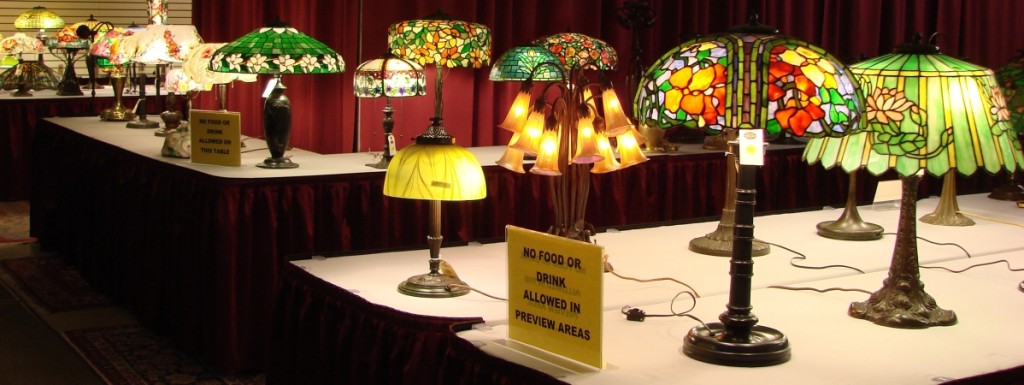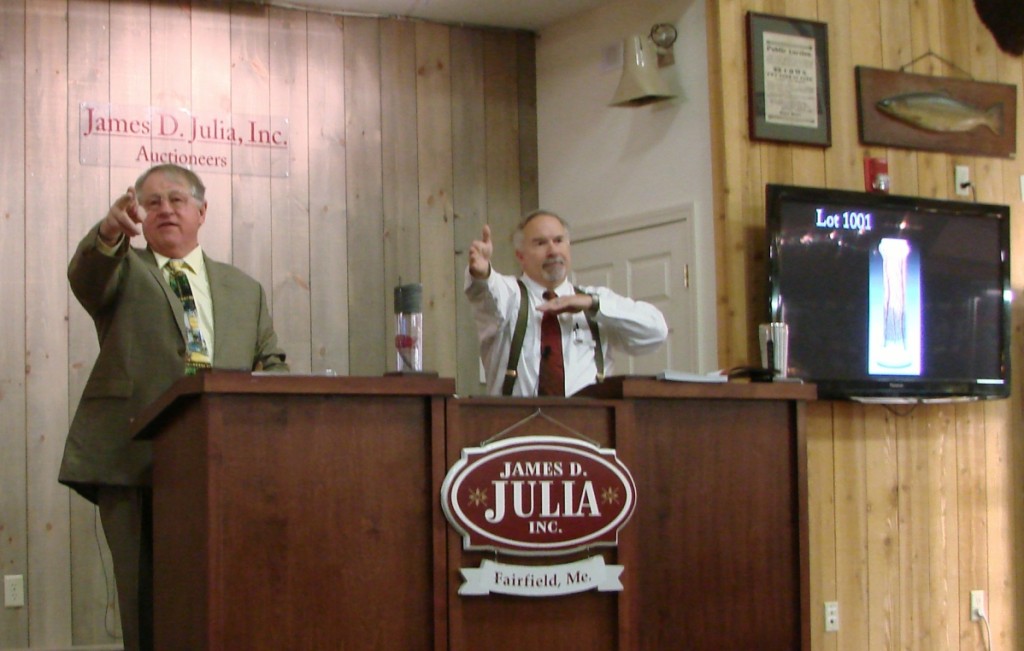Review and Onsite Photos by Rick Russack, Catalog Photos Courtesy James D. Julia Inc.
FAIRFIELD, MAINE – On December 1, Jim Julia and crew sold more than $2.5 million worth of French, English and American art glass, jewelry and leaded glass lamps. Tiffany lamps led the way, with three each bringing more than $84,000 and another exceeding $80,000. Other lamps, including examples by Handel and Pairpoint, did well, and jewelry was topped by a platinum and yellow diamond ring, which was bid to more than $20,000.
A Webb rock crystal cameo epergne topped $13,000, three Daum Nancy pieces exceeded $10,000, as did four pieces of Galle. As the sale progressed, there were more than 50 buyers in the room, more than ten phone lines were in use, internet bidding was available and there were numerous absentee bids.
As Julia was selling and waiting for a slow phone bidder to decide, he commented, “When a phone bidder is struggling with our language, whoever is on the phone with that bidder holds up an orange card. That lets me know that we’re having some difficulty communicating and I slow down, giving them time to be sure we’re getting it right.” About $1 million worth of material in the sale was being sold without reserve, and astute buyers in the room got some very good buys.
The sale comprised 739 lots, of which about 175 were Tiffany: lamps, bases, shades, Favrile glass, bronze, desk accessories, etc. Two Tiffany Studios leaded lamps, a Rose and Butterfly table lamp and a boldly colored Geranium table lamp, along with a Nasturtium chandelier, shared top honors for the day, with each bringing $84,700. A Gentian table lamp was not far behind, finishing at $81,675. The signed, boldly colored Nasturtium chandelier had mottled yellow and amber flowers with large mottled green leaves, set against a mottled blue background.
The signed Rose and Butterfly table lamp had yellow roses at the bottom of the shade with striated yellow and red butterflies above the roses, and it had an overall mottled blue and white opalescent background. It was on a Tiffany Studios bronze urn base. The signed Geranium table lamp had deep red geranium flowers, large striated and mottled green leaves, with a striated blue and white background. It, too, was on a bronze urn base.
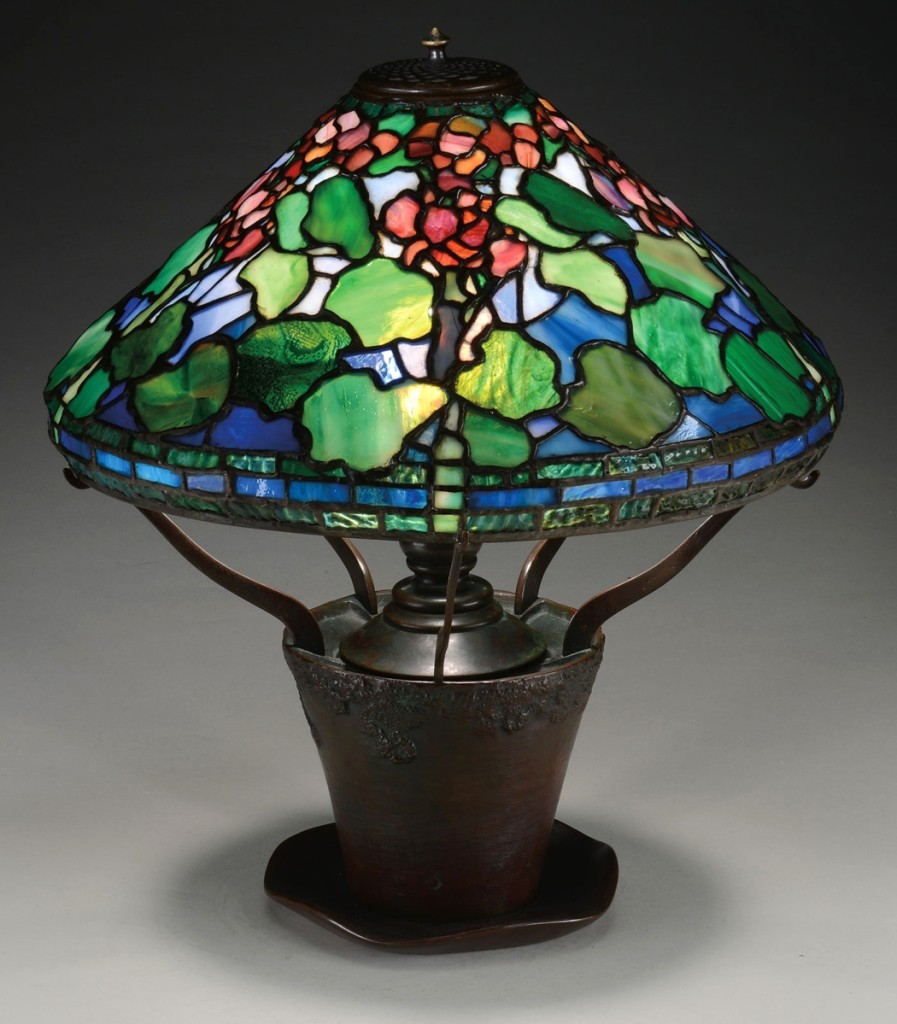
The signed Tiffany Studios Geranium pattern lamp, with a 16-inch shade, had red geraniums and mottled green leaves against a striated blue white background. It was one of three lamps that realized $84,700.
A signed lamp that was probably custom made had a monogram worked into the shade and an unusual pink tint to the glass. The shade was surrounded by a floral band of red, purple and orange flowers. The monogram on the front of the shade was also surrounded by a wreath of flowers and green leaves.
Numerous other lamps by Tiffany did well. A signed Dragonfly table lamp, with each dragonfly having striated red and cream colored wings, deep red bodies and blue eyes, randomly decorated with oval green glass cabochons, finished at $63,525, and a signed Crocus table lamp with mottled pastel yellow and white crocus flowers and emerald green stems finished at $54,450. An unusual, unsigned hall lamp, attributed to Tiffany Studios, sold for $51,425. Its bronze frame was decorated with 12 vertical panels, each with four large cabochons of opalescent glass and a band of smaller cabochons at the top.
This list of lamps bringing more than $20,000 each could go on – there were many. Bronze lamp bases also were strong, as one with a twisted vine design forming five arms supporting the shade ring finished among the top ten lots of the sale, bringing $48,400.
Mike Fredericks, head of Julia’s lamps, glass and jewelry division, explained that collectors judge the desirability of a given Tiffany lamp shade by the color and variety of the glass used in its construction. “All shades of a given style, Geranium, for example, will be made with the same pattern of leading and the same shape for each individual piece of glass in the shade,” he said. “They’re assembled on a wooden pattern. But each artist was free to select the glass to be used, and the value of a particular shade depends upon that choice of glass. Bolder colors are more desirable, and glass with striations, mottling and other inclusions will result in differing values in today’s market.”
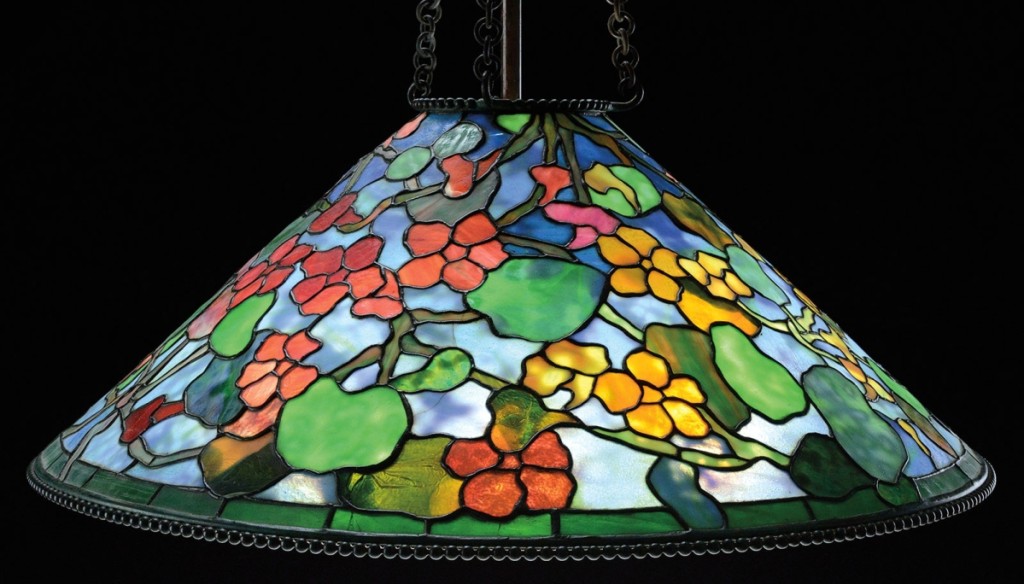
Also bringing $84,700, this signed Tiffany Studios 16-inch Rose and Butterfly table lamp had yellow roses and red butterflies over the roses.
Various forms of glass by Tiffany, including lamp shades, did well, often exceeding estimates. For example, a 10-inch-diameter green Damascene shade estimated at $4,500 brought $7,865. A free-form Favrile glass vase decorated with a Cypriote exterior and thick lavalike bands earned $6,050.
There were about 40 lots of other types of Victorian art glass, an area that has been weak in recent years. The material was sold without reserves, and several pieces indicated that there is still interest in the category. A Royal Flemish vase decorated on the front with a coat-of-arms within scrolls, in typical Royal Flemish colors, earned $6,665, more than four times the estimate. Another Royal Flemish vase was decorated on its front and back with a Venetian harbor scene showing ships at sail and birds in flight, with an outline of Venice in the background. It went for $14,520, more than three times the estimate.
The same collection included examples of peachblow, Burmese and Plated Amberina. Examples of the last mentioned type were also popular with bidders. A richly colored 7-inch Plated Amberina pitcher realized $7,260, and a 5½-inch syrup pitcher made $6,655. Both well exceeded estimates.
The sale started out with about 185 lots of French glass by Galle, Daum, Schneider and others. Some final prices exceeded their estimates, while some pieces, sold without reserve, may have been good buys. Bidders in the room seemed to be best positioned to take advantage when unreserved pieces were offered. Julia’s sales are fast-paced, and on some of the unreserved lots, the auctioneer was able to open the bidding at a price well below the low estimate.
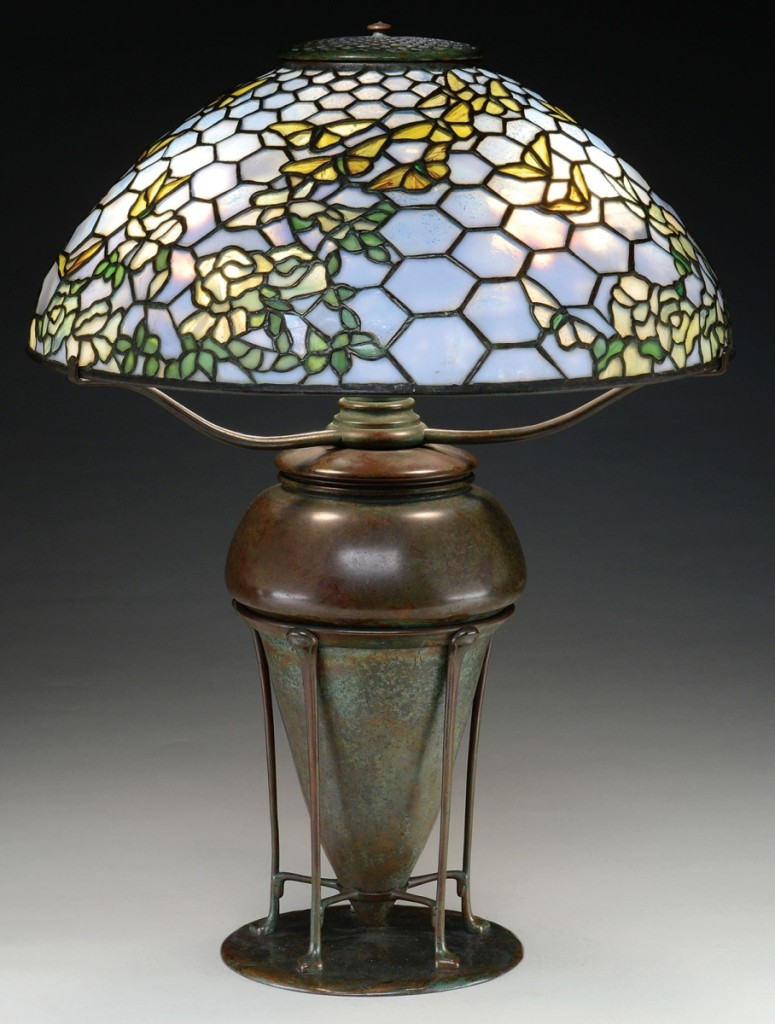
In a three-way tie for the highest priced lot, this signed Tiffany Studios boldly colored Nasturtium pattern chandelier, just under 29 inches in diameter, with mottled yellow and amber flowers and large mottled green leaves, finished at $84,700.
The first lot of the sale was a Daum Nancy cylindrical vase carved and enameled with a colorful farm scene with a blue sky, greens and yellows. It finished at $10,890, well above the $7,000 estimate. The highest price for a Daum Nancy example was earned by a piece a without reserve. Bringing $15,125 was a rare Corbeau et Grenouille cameo vase with a raven resting on a branch and a frog below. The leafless branches were set against a mottled amber background. The cameo frog and flowers were gilded and the vase was signed Daum Nancy with the Cross of Lorraine.
Mold blown pieces were the most popular of the Galle offerings, as a brightly colored red rhododendron vase with deep green leaves and stems against a frosted amber background made $18,150, well over estimate. From the catalog, “The unique glass in this vase is somewhat dichroic, when it is unlit, the leaves are a rich green color and the flowers are bright red, when backlit the vase appears in shades of red/amber.”
Another mold blown piece with red cherries along with green and red leaves and stems, set against a peach-colored background, also topped estimate, realizing $11,495.
A Galle piece utilizing an unusual technique also did well. The blue opalescent glass vase was subtly decorated with cameo and engraved figures of fishermen landing large fish, with trees and an island in the distance. Remnants of a red patination remained in some areas and it brought $11,495.
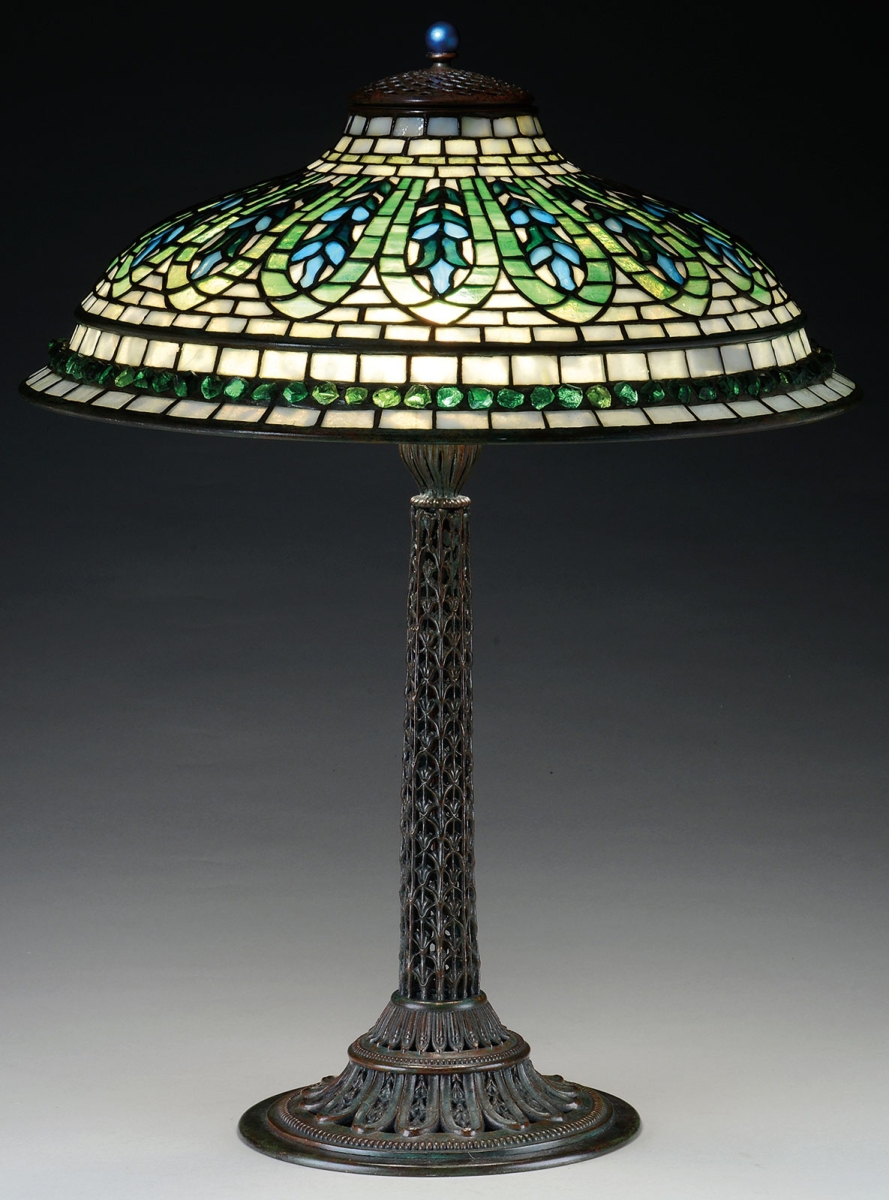
The fourth highest priced Tiffany Studios lamp was a Gentian table lamp. It had blue flowers descending from the neck, and each of the flowers was outlined in mottled green glass. The final price was $81,675, well over the estimate.
A dealer in the room who bought several pieces of French glass, including some of the unreserved pieces, commented, “The market for French glass has notably improved over the last three or four years. Prices peaked in the late 1980s and early 1990s, and then decreased. But we’re seeing new collectors coming into the field. I don’t mean to say ‘young collectors.’ The new buyers seem to be professional people who have some extra money to spend after they’ve put their kids through college or paid off a mortgage.” When asked what sort of homes the new buyers are in, the answer was “almost all live in modern homes or apartments. I don’t think any is going into colonial-style homes.”
One of the surprises of the sale was the strong interest shown in William DeMorgan ceramics. He was an English potter associated with William Morris in the mid- to late Nineteenth Century, who later set up his company. There were two lots with chargers he produced. One lot had three, and that lot sold for $21,780 – seven times the estimate. The second lot had two examples, and it brought $10,890, four times the estimate.
Mike Fredericks later said, “DeMorgan’s work preceded Wedgwood’s Fairyland Lustre and there’s strong European interest in DeMorgan’s works. We don’t see much of it. We had several European bidders on the phones for these lots.” There were also several lots of Fairyland Lustre, some of which were passed, but a brightly colored vase in the Goblin pattern realized $10,890, slightly over the reserve. Wedgwood introduced Fairyland in about 1915.
When Fredericks was asked about the state of the glass market today, he responded, “It’s certainly not what it was, but I think the market in general has been steady and improving for the last four or five years. Some categories are stronger than others, but examples of rare techniques will still bring strong prices.”
Prices reported include the buyer’s premium. For information, www.jamesdjulia.com or 207-453-7125.

